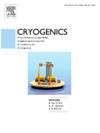泰坦潜艇的三维气泡建模
IF 2.1
3区 工程技术
Q3 PHYSICS, APPLIED
引用次数: 0
摘要
在美国宇航局创新先进概念(NIAC)研究的第二阶段,一艘外星潜艇被研究用于探索土星的卫星土卫六。潜艇的主要设计问题之一是气泡对潜艇操作的影响。氮气在土卫六富含甲烷的丽姬亚海中是高度可溶的。来自海底动力系统的余热可能会导致溶解的氮气从溶液中出来;在静止的情况下,形成的气泡可能会干扰科学仪器,在运动的情况下,沿着潜艇形成的气泡可能会在尾部聚集,导致螺旋桨空化。本文介绍了第二阶段轨道支撑潜艇,更新的任务概况,关键子系统,以及量化泡沫作为丽吉亚海内位置和操作的函数所需的相关模型。一期和二期潜水器的设计也进行了比较和对比。本文章由计算机程序翻译,如有差异,请以英文原文为准。
3D effervescence Modeling of a Titan submarine
An extraterrestrial submarine was studied to explore Saturn’s moon Titan, under a Phase II NASA Innovative Advanced Concepts (NIAC) study. One of the primary design concerns for the submarine is the effect of effervescence on submarine operation. Nitrogen gas is highly soluble in Titan’s methane-rich sea, Ligeia Mare. Waste heat from the submarine power system may cause this dissolved nitrogen gas to come out of solution; in a quiescent case, bubbles that form may interfere with science instruments, and in a moving case, bubbles that form along the submarine may coalesce at the aft end and cause cavitation in the propellers. This paper introduces the Phase II orbiter-supported submarine, updated mission profile, critical subsystems, as well as relevant models needed to quantify effervescence as a function of the location and operation within Ligeia Mare. Phase I and Phase II submersible designs are also compared and contrasted.
求助全文
通过发布文献求助,成功后即可免费获取论文全文。
去求助
来源期刊

Cryogenics
物理-热力学
CiteScore
3.80
自引率
9.50%
发文量
0
审稿时长
2.1 months
期刊介绍:
Cryogenics is the world''s leading journal focusing on all aspects of cryoengineering and cryogenics. Papers published in Cryogenics cover a wide variety of subjects in low temperature engineering and research. Among the areas covered are:
- Applications of superconductivity: magnets, electronics, devices
- Superconductors and their properties
- Properties of materials: metals, alloys, composites, polymers, insulations
- New applications of cryogenic technology to processes, devices, machinery
- Refrigeration and liquefaction technology
- Thermodynamics
- Fluid properties and fluid mechanics
- Heat transfer
- Thermometry and measurement science
- Cryogenics in medicine
- Cryoelectronics
 求助内容:
求助内容: 应助结果提醒方式:
应助结果提醒方式:


